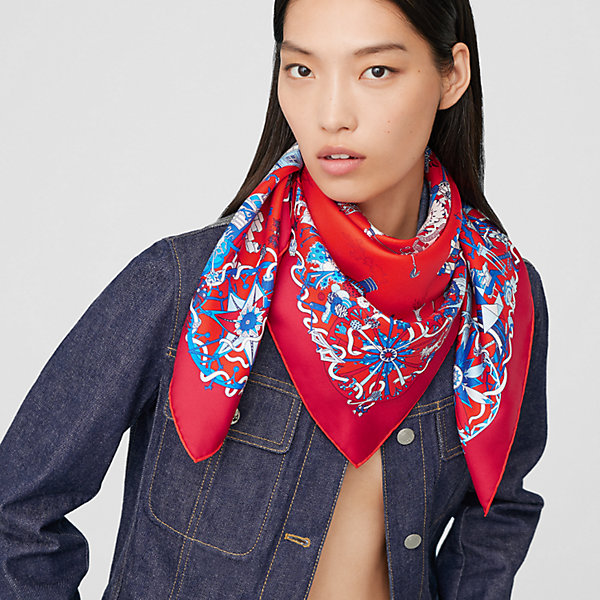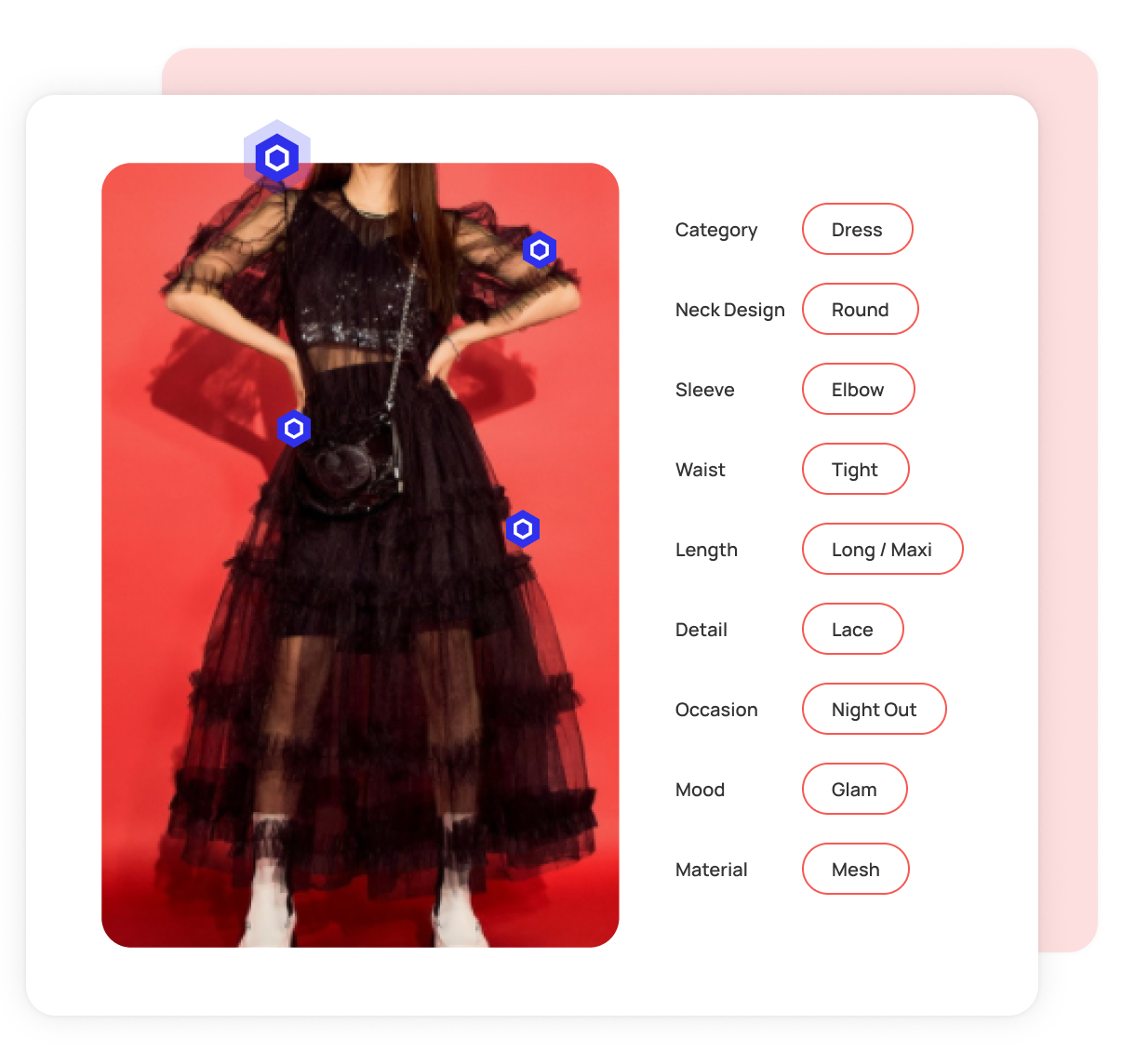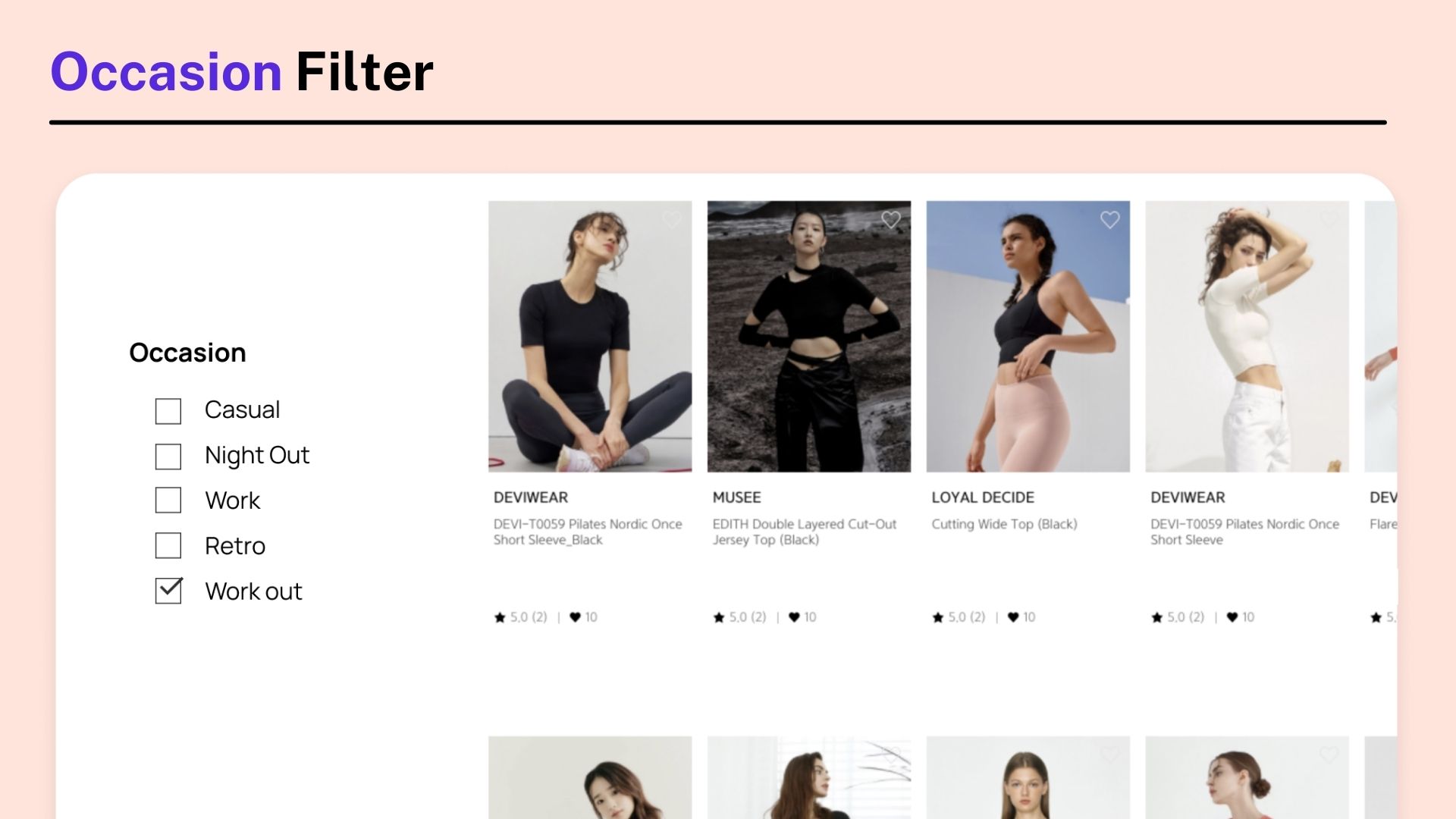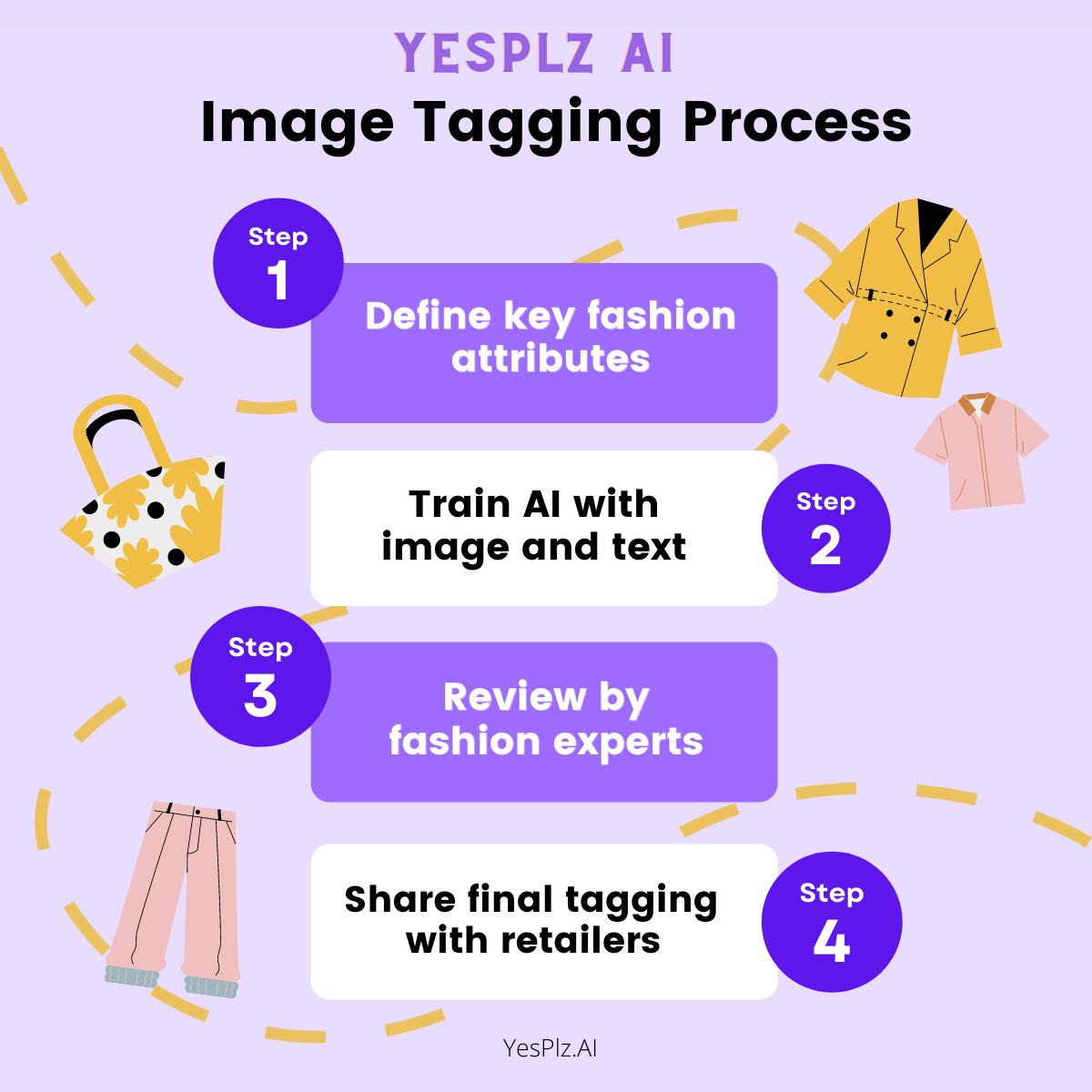Understanding Customer Search Intentions in Fashion eCommerce
by Jess Erdman, Content Marketing LeadFebruary 2021

How would you describe the fabric that the model is wearing in the picture?

To some, the model is wearing a scarf. Or a bandana. Or a kerchief.
Depending on regionalisms and knowledge of fashion products, you may have one or more words to call a "scarf."
While diversity in language has allowed for rich, accurate eCommerce product descriptions, it has also created a problem for retailers and customers: a confusing, unclear fashion taxonomy.
Fashion taxonomies are associated with text-based search queries and can be limiting for users. For example, if you had searched for the term “scarf” instead of “bandana,” depending on the retailer, you’d be left with empty search results.
Not every customer is an expert in the language of fashion products--and your search system shouldn’t expect customers to be experts.
And, for retailers, complex eCommerce taxonomy creates an unmanageable system for classifying product information.
At YesPlz, we have a solution that solves the problem of fashion taxonomy and answers the questions of what users really want: a visual Virtual Mannequin Filter that allows customers to demonstrate the attributes they’re looking for on a model.
Learn how to elevate the product discovery experience
As a fashion retailer, it’s key to understand fashion taxonomy and they affect your customer search behavior. In this guide, we’ll outline different user search intentions, and how you can better meet those needs.
We’ll go over:
In general, taxonomy is the science of naming, describing, and classifying items into categories. Taxonomy is essential in fashion because of the large number of products inherent in the industry, and it points us in the right direction to help us find products.
In theory, fashion taxonomy is an inevitable evil for every eCommerce retailer to conquer--how else would eCommerce retailers even begin to categorize the multiple attributes related to each item?
However, fashion taxonomy has become unmanageable for retailers to keep up with. If fashion taxonomy is defined as a “living, breathing thing,” there’s no way for retailers to keep up because terminology is constantly changing. For example, "mermaidcore" is on track to be a trend for summer 2023.
While taxonomies make sense in static scenarios(such as the animal kingdom), it doesn’t make sense for retailers to constantly catch up with ever-evolving fashion terminology.
And, it’s likely that in trying to play a game of catch-up, retailers are still just a little bit too late to the terminology--after all, no retailer has time to search all of the internet for up and coming terms.
But, with powerful fashion AI, retailers can create smart product filters, enhanced text search that taps into popular, trending keywords, and new eCommerce discovery experiences for shoppers.
Difficult-to-understand fashion taxonomies mean that customers are unable to find products that match their search intentions.
When a customer searches for a “bandana” instead of “scarf” and receives mismatched search results, it’s a failure on the part of fashion taxonomy.
Based on our 2023 shopper research, customer expectations are higher than ever. As a result of the pandemic, customers' digital sophistication skyrocketed, leaving sky-high expectations alongside the newfound sophistication.
For example, shoppers expect, at a bare minimum, search accuracy as well as personalization during their eCommerce search experiences.
When customers choose which words to write in the search bar, there’s a world of intentions behind their choices.
Some customers have a specific problem they’re trying to solve (“dresses that cover shoulders”) or a specific feature(s) in mind (“satin, button-up A-line dress”). Each of these customers has a different goal, and it’s vital that your search system recognizes the differences.
Unless your customer uses the exact terminology that aligns with eCommerce product tags (more on that below), they may miss out on products--or an entire category.

Contact YesPlz for a free 20-min demo
Every customer fits into a different “search persona”--and some are a combination of different personas.
According to Baymard, there are 4 key search intentions your eCommerce website should be able to support. Below, we’ve created a search persona to accompany the definitions.
1) Exact: The customer has a specific goal in mind
2) Product: The search is intended for a product category, but not necessarily a specific brand.
3) Feature: The customer is looking for a special feature or detail.
4) Thematic: The search is based on a “theme” such as a special occasion or season.
Can your search system support all of the above searches? Hint: Thematic is the most difficult.
This customer knows exactly what she wants, and takes no time to hesitate when typing in her search terms. She can identify the exact brand, dress style, and season. The customer has a specific idea in mind and expects to see an exact match in the result--and might be short on time.
Where Fashion Taxonomy Falls Short: Because of the specificity and speed of the search, the customer may misspell the brand name or mistype a model. Unless the retailer’s fashion taxonomy is mapped in a way to recognize misspellings, she may not receive any results in return. As a customer on a mission, she’ll likely bounce to a different website to continue the search.
This customer has a product category she’s interested in (dress pants, for example), and is looking to explore the category of search results. She wants to see relevant results (and perhaps product suggestions) that complete the search.
Where Fashion Taxonomy Fall Short: Our “willing to explore” customer is likely to become victim to fashion taxonomy terminologies. Take the example above--” dress pants.” There are many different regionalisms and ways to interpret the term, and if she doesn’t know that the retailer calls them “trousers,” she may receive no search results--or, a combination of dresses and pants.
The customer is all about the details--after all, that’s what makes fashion interesting. She wants a cropped vegan leather jacket, under $200. Her expectations are high-- most major fashion brands highlight their clothing features, and she expects nothing less in the eCommerce experience.
Where Fashion Taxonomy Fall Short: As we explained above, fashion taxonomies require constantly updating product features--and an understanding of relevant terminologies. As more features are added to the search, it’s more likely that one of the features that our Fashionista is looking for won’t be named correctly.
The customer is looking for the perfect dress to wear to a wedding--or perhaps a cozy fall jacket. These are examples of thematic searches, and are difficult for retailers to capture, but are an example of how we, as humans, think.
We intrinsically know that a casual denim dress isn’t wedding-appropriate attire, but that’s because, just like the themed-searcher, we’ve mapped out those relationships in our minds. The themed-searcher is the most difficult to please--46% of the top eCommerce websites weren’t able to meet thematic search needs.
Where Fashion Taxonomy Fall Short: Fashion taxonomy is, at its core, a system created by humans. Unless the humans behind the taxonomies have considered every possible relationship (which changes based on demographics such as gender, location, economic status) between occasions, seasons, and clothing, it’s impossible to map out all of the possible relationships. Therefore, it’s likely that the thematic searcher will receive few, if any, search results and assume that the fashion eCommerce site doesn’t have the appropriate products for her needs.

Occasion (or thematic) filters offer a way for shoppers to search by their favorite occasion or vibe, from wedding-guest to a night-out. While thematic filtering has proven to be challenging for retailers, YesPlz makes it seamless by using AI-powered tagging to accurately label products for occasions. Then, using the tags, we create smart product filters. The end result? Shoppers can easily filter by their favorite occasion, retailers don't need to build technology in-house, and product filtering becomes more enjoyable.
Fashion tagging and fashion search go hand-in-hand. When a customer types her search intention into a search bar, she expects to receive accurate search results. But, behind the scenes, inaccurate product tagging can result in a mismatch between search intention and results.
For example, a product tagged as a "fit and flare skirt" might not appear in search results if the customer searches for an "A-line skirt." As we know, the language of fashion can be confusing and inaccurate. When we factor in the fact that third parties are responsible for product tagging, this can lead to inconsistent product tags (after all, we all have different fashion vocabulary). Alternatively, in-house merchandising experts may also make mistakes.
How can we eliminate those mistakes? By using fashion artificial intelligence to tag images, we eliminate human error and increase product tagging accuracy, leading to a rich shopping experience.
YesPlz AI can provide fast, accurate fashion tagging that understands fashion. Our AI is trained to recognize product attributes in all types of pictures, even low-quality images, and is then reinforced with the input of fashion experts.
Here's more about our fashion image tagging process:

Search is at a turning point. Text-based fashion taxonomies are creating barriers for customers to find products easily and accurately. And shoppers are demanding more from retailers, as they value seamless product discovery.
Simultaneously, AI technology is more advanced than ever. Open AI's ChatGPT has transformed the way that the world views AI, making it accessible for everyone on a daily basis.
However, what’s next for fashion eCommerce?
YesPlz AI is building combined AI technology to make fashion search and recommendations even more powerful.
For example, YesPlz's ChatGPT Fashion Stylist uses NLP, generative AI, and computer vision to create the world's first AI stylist that uses ChatGPT. Shoppers have an AI-powered product discovery experience, as they discover new products through a conversation with an AI stylist.

The future of search is moving away from text-based, static search systems and into AI-powered solutions that take into account customer search intentions. That way, we can curate product discovery experiences that are better than ever.
Written by Jess Erdman
Content Marketing Lead
I'm passionate about creating cool content. The best part? I get to learn new things about fashion tech and ecommerce everyday. Have an idea or opinion about this article? Reach out at jess@yesplz.ai

Discover what AI tagging is, how it works, and why it’s essential. Learn its benefits, real world use cases, top AI tagging tools, and tips for implementation.
by YesPlz.AI

Discover how to maximize Shopify’s default search and discovery apps with actionable tips and AI-powered strategies. Learn to automate and optimize your store’s discovery experience for better results.
by Jiwon HongFounder at YesPlz AI